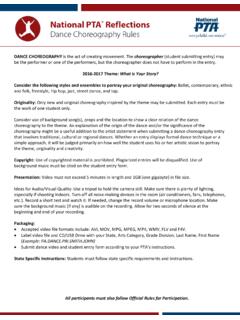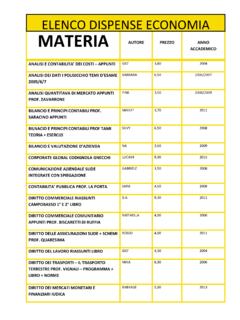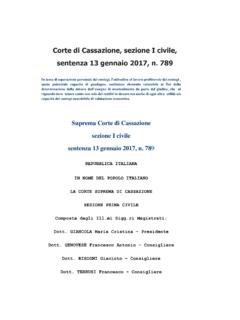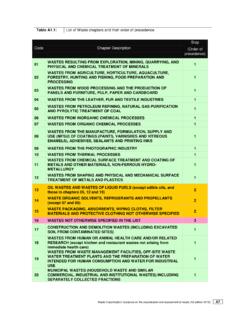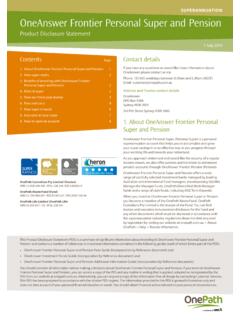Transcription of Criminal Law 1
1 Criminal Law 1 Case Digests DEAN S CIRCLE 2019 UST FACULTY OF CIVIL LAW 1 University of Santo Tomas Faculty of Civil Law Espa a, Manila Criminal Law 1 (Revised Penal Code and Related Laws) By Judge OSCAR B. PIMENTEL (Ret.) Preliminaries: Definition and Meaning of Terms and Phrases. Definitions/Meaning 1. Criminal Law 2. Crimes 3. Felonies 4. Offenses 5. Infraction of the Laws 6. Ordinances 7. Act 8. Omission 9. Mala en Se 10. Molum Prositum 11. Venue 12. Jurisdiction 13. Continuous Crime 14. Continuing Crime 15. Impossible Crime Different Terms and Phrases and their Meaning: 1. Due Process 2. Ex Post Facto Law 3. Bill of Attainder 4. Prohibition against Excessive Penalty of Imprisonment and Fines Principal parts of Criminal Law under the Revised Penal Code: 1.
2 Arts. 1-20 Basic Principles Affecting Criminal liability 2. Article 21 to 113 Provisions on Penalties including Criminal and Civil liabilities 3. Articles 114-365 Felonies defined under 14 different titles. The Fourteen (14) Different Titles are: 1. Arts. 114-123 Crimes against National Security and the law of Nations 2. Arts. 124-133 Crimes against the Fundamental Laws of the State 3. Articles 134-160 Crimes against Public Order 4. Articles 161-189 Crimes against Public Interest 5. Articles 190-194 Repealed by Republic Act 6425, 7659 and 9165 as ____ - Law on Opium and Prohibited drugs (New special Penal Law) DEAN S CIRCLE 2019 UST FACULTY OF CIVIL LAW 2 6. Articles 195-202 Crimes against Public Morals 7. Articles 203-245 Crimes committed by Public Officers - ___ - A, B, C and D 8.
3 Articles 246-266 Crimes against Persons 9. Articles 267-292 Crimes against Personal Liberty and Security 10. Articles 293-332 Crimes against Property 11. Articles 333-346 Crimes against Chastity 12. Articles 347-352 Crimes against Civil Status of Persons 13. Articles 353-364 Crimes against Honor 14. Article 365 Quasi offenses characteristics of Criminal Law 1. General 2. Territorial 3. Prospective Exception to Generality (a) Treaty Stipulations (b) Laws Preferential Applications Exceptions to Territoriality a) Article 2 of the Revised Penal Code 1. Rules on Philippine Vessel or Airship 2. Foreign Vessel (a) French Rule (b) English Rule Exception to Exception (a) When the New Law is Expressly made in applicable (b) Offender is habitual Criminal The Three (3) Theories of Criminal Law 1.
4 Classical Theory 2. Positivist Theory 3. Mixed or Ecclectric Theory Constitutional limitation on Power of Congress in enacting Penal or Criminal Laws Penal Laws that cannot be passed: (a) Ex Post Facto Law (b) Bill of Attainder (c) Equal Protection Clause (d) Cruel, Unlawful and Unusual Punishments (e) Excessive fines (f) Due Process DEAN S CIRCLE 2019 UST FACULTY OF CIVIL LAW 3 How Penal Laws are to be construed (1) It should be liberally construe in favor of the accused and strictly against the state as long as: (a) The offender must clearly fall under the term of the law (b) An Act or Ommission is only Criminal when provided by a statute (2) In cases of conflict with the official translation, the original Spanish Text is controlling over the English translation (3) No interpretation by Analogy Article 1 Effectivity of the Revised Penal Code (Act No.)
5 3815 as Amended) History of the Revise Penal Code (US vs. Tamparong, 31 Phil. 321-323) (see also Sayo vs. Chief of Police of Manila, 80 Philippines 859) The Code Committee that Revised the Penal Code. The Code Commission which Revised the Penal Code The code commission was created by Executive Order No. 48, dated March 20, 1947, prepared the Code of Crimes, which has not been enacted to law which states that criminality depends mostly on Social factors, environmental, education, economic conditions or inborn or hereditary character of the Criminal himself. The Classical Theory stresses the objective standard of crime, and imposes a proportionate punishment therefore, but the positivist school considers the deed as secondary and the offender as primary, and the means of repression to protect the society from the actor to fonstall the social defense because it takes the view that crime is essentially a social and natural phenomena.
6 The Code Committee The Code Committee which revised the Penal Code was created by Administration Order No. 94 of the Department of Justice dated October 18, 1927, and was composed of Justice Anacleto Diaz, as Chairman and as members, Messrs. Quintin Paredes, Guillermo B. Guevarra, Alex Reyes and Mariano H. de Joya. The Committee was entrusted with the preparation of a revised draft of the Penal Code, taking into consideration (1) Penal Legislation found in our statute books, (2) the rulings laid down by the Supreme Court and (3) the present conditions of these Islands. Various Penal Acts which were enacted during the early years of the American Administration were incorporated into the Revised Penal Code, among them are the Malversation, Opium, Brigandage, Libel, Treason and Sedition Laws.
7 The Revised Penal Code was approved as Act No. 3815, of the Philippine Legislature on December 8, 1930. It took effect on January 1, 1932. Felonies: a) Classification b) Criminal Liability c) Impossible Crimes d) Stages of Execution e) Conspiracies and Proposals f) Multiple Offenders g) Complex and special Complex Crimes DEAN S CIRCLE 2019 UST FACULTY OF CIVIL LAW 4 Classifications: (1) Article 3 Definition (a) Delito (1) Dolo/Desit (2) Culpa/fault (b) Ommissions Classification of Felonies (a) Intentional (b) Culpable #Accident #Mistake of fact US vs. Ah Chong - 15 Phil. 488 People vs. Bayambao 52 Phil. 309 US vs. Pe alosa, et al, 1 Phil. 109 US vs. Apego 23 Phil 391 #Mistake in Identity/fact People vs. Gana, 54 Phil.
8 603 People vs. Oanis, et al. People vs. 74 Phil 257 People vs. Monasalapa, et al 92 Phil. 639 #Mistake in the blow. (Aberratio Ictus) While acting in self defense, but hit a third person is justified if the elements of self defense are present. characteristics of a Felony (a) There must be an act or omission (b) That is punishable by law (c) The act is done by means of dolo or culpa Requisite of Dolo/Intentional felonies (a) Freedom (b) Intelligence (c) Intent Culpable felonies Requisites (a) Freedom (b) Intelligence (c) Negligence (lack of foresight) (d) Imprudence (lack of skill DEAN S CIRCLE 2019 UST FACULTY OF CIVIL LAW 5 Article 4 Criminal Liability (a) Praeter Intentionem (b) Impossible crimes Where there is malice there is no negligence People vs.)
9 Guillen 85 Phil 302 US vs. Ah Chong 15 Phil. 488 US vs. Bautista 11 Phil. 308 Calderon vs. People 96 Phil. 216 People vs. Guevarra 23 SCRA 58 Dolo distinguished from Culpa People vs. de Fernando 49 Phil. 75 People vs. Aguilar and Oliveros 109 Phil 847 People vs. Lingad 103 Phil. 980 People vs. Ramirez 46 Phil. 204 Motive People vs. Dorico, et al 54 SCRA 172 People vs. Herilla 51 SCRA 31 People vs. Murray 105 Phil. 591 Presumptions People vs. Marco 83 SCRA 338 People vs. Panasa 47 Phil. 48 People vs. Reloj 43 SCRA 526 Exempting Circumstances because of lack of intelligence. 1. Mentally, unbalanced person (insane, intelcille, etc. Article 12 par. 1) 2. Children who are 15 years old and below (par. 2 Article 12 as Amended by RA 10630) 3.
10 Children who are over 15 but below 18 years old who did not act 2with discernment (par. 2, Article 12) 4. Those who act under mistake of fact Exempting circumstance because freedom is absent 1. Compulsion of an irresistable force (Art. 12 par. 5) 2. Impulse of an uncontrollable fear and equal or greater injury (Art. 12 par. 6) Art. 4 Criminal Liability 1. Praeter Intentionem 2. Impossible crimes DEAN S CIRCLE 2019 UST FACULTY OF CIVIL LAW 6 Boxing bout resulting to the death of one of the boxers is not unlawful. Liable for direct, natural and logical consequences of one s act People vs. Cardenas 36 SCRA 631 People vs. Toling 62 SCRA 17 People vs. Monleon 74 SCRA 263 Proximate Cause Villanueva vs. Medina 102 Phil.


